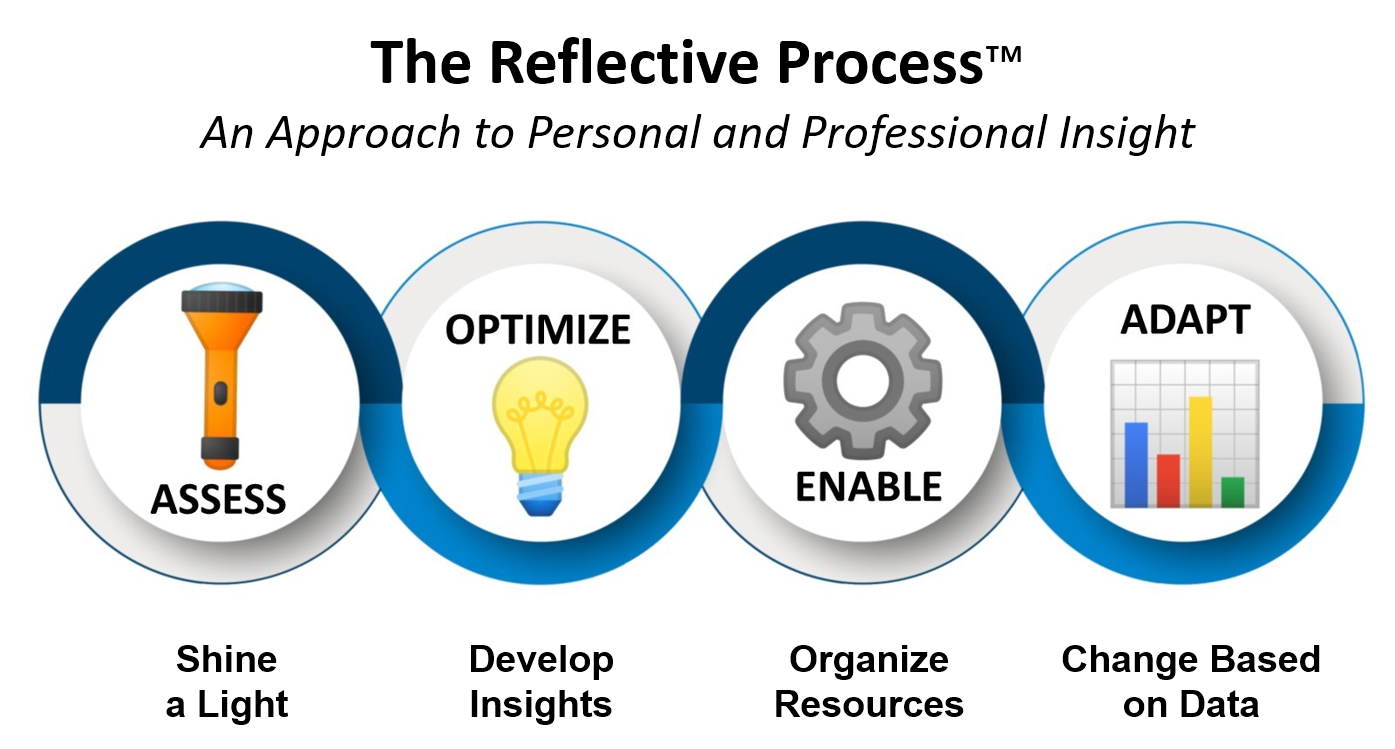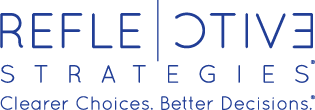Whether helping a client to launch a new business or change a long-established program, my advisory approach generally involves four actions, which are part of what I call the Reflective Process™. For years, I’ve written and spoken on the methods embedded within this framework, more recently adding mindfulness principles and practices. I use proven tools throughout, customizing them to my clients’ unique needs. I also provide holistic coaching support to my clients.

1. Assess
We work together to understand the current state and identify any issues to be addressed, shining a light on what’s working and not working.
- What’s causing the need for an outside adviser? Is this the right set of issues to be focusing on right now?
- How well understood is this need and by whom? Who will enable or, possibly, impede change?
- What questions should we be asking to understand the current situation and envision future possibilities?
- What are the goals of doing the work and the anticipated benefits, including the personal goals of leadership? How do these relate to broader organizational priorities?
Case Example
Working with a major health system in a multi-year effort, I’m helping to map the current, non-clinical (psycho-social, financial, and logistical) support services being offered to patients, identify any future state possibilities for even more robust programs, assess key stakeholders and their needs and interests, and determine how any new services would help meet the organization’s goals.
2. Optimize
I help clients develop and test ideas about how to take advantage of opportunities/fix any problems arising from the current situation and create a better future state.
- Given timing, competitive, and resource constraints, what’s the best thinking right now about how to seize the opportunity or address the problem?
- For each of the preferred approaches, what are the pros and cons, including the costs of action and inaction?
- What combinations of actions are likely to produce the best results and under what conditions?
- What specific goals can be attached to these actions?
- What will the future look like if the plans are achieved?
Case Example
Working with a healthcare start-up, I’m advising this seed-round company in its efforts to target its patient medical adherence application to assist both “worried well” consumers and those with chronic illnesses to modify behaviors to stay healthy. I’m assisting the founder/CEO and advisers to systematically identify target markets and enlist funders, as well as anticipate the operational requirements of scaling the business.
3. Enable
With understanding of what’s happening and ideas about possible ways forward, I help leaders to develop options for how to make things happen and identify what, specifically, needs to be done and when.
- What’s the priority and best sequencing of actions to drive results?
- Who needs to be on board and what do they need to be doing?
- What early wins can help validate the work and keep momentum going?
- What are the best ways to track and measure progress?
- What messages should be communicated to stakeholders, including employees, customers, and board members?
Case Example
I worked with the board of a national medical association to enhance the impact and influence of its physician members in providing personalized diagnostic services as part of the patient care team. We developed a multi-year plan, performance scorecard, board reporting system, and strategic communications plan to help guide investments and monitor progress.
4. Adapt
I help clients bring insights not possible during planning. On the ground experience makes clear needed changes in approach and timing, new or revised goals, and any changes in the story being told about the work being done.
- What has happened that clients didn’t expect?
- How important are these contingencies?
- How might clients need to modify plans in response?
- What project objectives and timelines need to be revised based on progress to date?
- How will work on this project impact overall organization performance now and in the future?
- Anticipating possible impacts, what signals need to be sent to stakeholders?
Case Example
I helped a human services non-profit respond to the inevitable growing pains of becoming a national organization–assessing the challenges of scaling and program replication, expanding funding, communicating a compelling story of growth and change, enlisting new funders, evolving its governance structures, and shifting program priorities when the status quo was no longer working.



